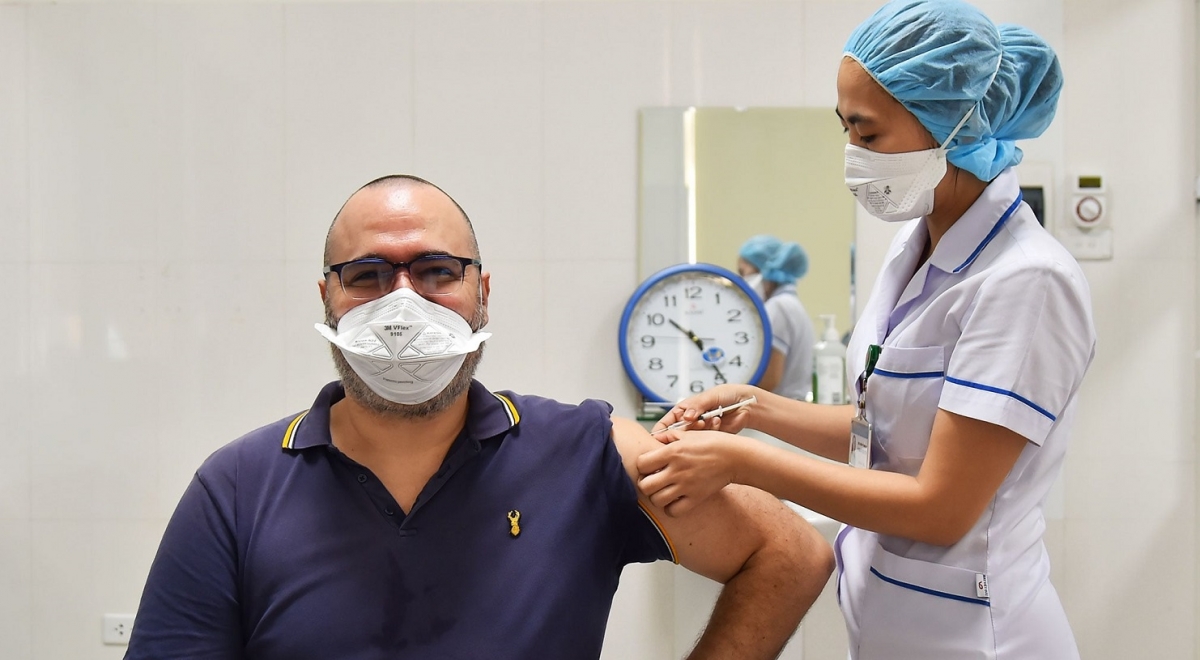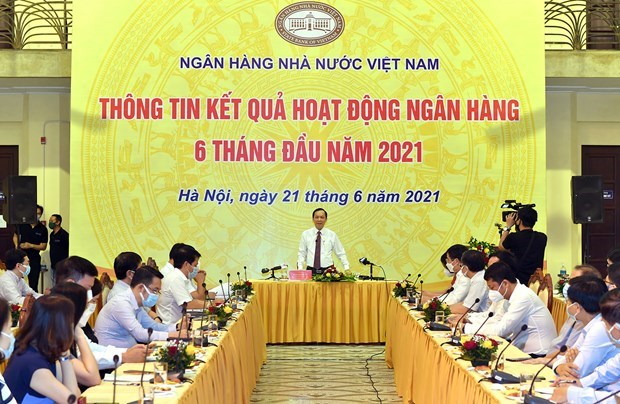
A foreign diplomat has received a COVID-19 vaccine shot in Hanoi. (Photo: MoH)
The vaccination, initiated by the Ministry of Foreign Affairs in collaboration with the Ministry of Health, was carried out by doctors of the Central Lung Hospital in Hanoi on June 9-10.
Diplomats and their staff were required to make health declaration and undergo medical check-ups before getting the jab.
None of the serious reactions were reported after the vaccination, said sources from the hospital.
Members of foreign diplomatic missions highly appreciated Vietnam’s epidemic prevention and control, especially its early COVID-19 vaccination.
Meanwhile, Vietnamese diplomats and their staff in many foreign countries regions have also been vaccinated against COVID-19, with WHO-licensed vaccines such as Pfizer-BioNTech, Astra Zeneca, Moderna, Sputnik V, and Sinovac.
Vietnam has logged a total of 9,943 cases of local transmission in the latest coronavirus wave that hit the nation nearly two months ago.
On June 21, a further 175 patients were declared free from the virus, boosting the total recoveries to 5,229, while the death toll has increased to 66 following the confirmation of two COVID-19 fatalities.
Vietnam is accelerating the COVID-19 vaccination campaign as well as greater efforts to secure 150 million vaccine doses this year for the target of inoculating 70% of its population to achieve herd immunity in 2021.
As of June 20 morning, nearly 2.4 million doses of COVID-19 vaccine had been rolled out in the country, with 115,315 people having received full two doses, according to the Ministry of Health.
Garment-textile exports hit 15.2 billion USD in five months: VITAS
Export revenue of the garment and textile sector surged 21.2 percent year on year in the first five months of 2021 to about 15.2 billion USD, according to the Vietnam Textile and Apparel Association (VITAS), reported VNA.

Illustrative image (Source: VNA)
The association reported that fibre and yarn exports during January-May soared by 60.1 percent year-on-year to 2.1 billion USD, while that of fabrics also increased 26.4 percent to 947 million USD.
In the period, Vietnam spent more than 10.2 billion USD on importing materials for the garment and textile industry, representing a 33.4 percent increase over the same period in 2020.
The Ministry of Industry and Trade attributed the growth to positive signals from the country’s major export markets as well as domestic businesses’ effective utilisation of opportunities from free trade agreements (FTAs) which have been signed and put in place.
The United States remained the largest importer of Vietnam’s garment and textile products with a value of 6.02 billion USD, up 24.4 percent from the same period in 2020 and accounting for 49.2 percent of the sector’s total revenue.
Japan was the second largest customer with 1.31 billion USD (down 6.3 percent), followed by the European Union with 1.21 billion USD (up 14.7 percent) and the Republic of Korea at 1.07 billion USD (up 4.2 percent).
Flexible monetary policy helps recover credit growth amid pandemic
The State Bank of Vietnam (SBV) has flexibly operated monetary policy tools to maintain liquidity for the banking system, contributing to stabilising and recovering credit growth in the context of unpredictable impacts of the COVID-19 pandemic, reported VNA.

Participants at the press conference (Photo: VNA)
The information was announced by the SBV at a press conference on June 21 to review the banking sector’s activities in the first half of 2021.
According to SBV Deputy Governor Dao Minh Tu, thanks to synchronous management solutions, as of June 15, total credit in the economy expanded 5.1 percent from the end of 2020. The credit growth rate in the same period last year was only 2.26 percent
Attention has been paid to strictly controlling credit for areas with potentially high risks, and taking measures to remove difficulties facing enterprises and people in accessing bank credit, he said.
Total M2 payment vehicle - one of the tools to measure the level of "pumping money" into the economy from the banking system – in the period increased by 3.96 percent compared to the end of 2020 and surged 14.27 percent over the same period last year. The credit institution system maintains smooth liquidity.
The sector has continued to manage interest rates in line with the macro-economic balance, inflation, market movements and the objectives of the monetary policy, contributing to cutting capital costs for people, businesses and the national economy.
A series of measures have been implemented to support borrowers amidst the COVID-19 pandemic, helping them restructure cash flows, and revive production and business activities.
As of May 31, credit institutions have rescheduled debt repayments for 257,602 borrowers with total outstanding loans of over 336.6 trillion VND (14.61 billion USD), exempted or reduced interests for 676,690 customers with total outstanding loans of over 1.2 quadrillion VND, provided new loans with low interest rates totaling over 3.5 quadrillion VND for nearly 481,000 borrowers.
Regarding the form of payment and transaction, Director of the SBV’s Payment Department Pham Tien Dung said non-cash payment activities have been expanded in the last six months.
Payment transactions via Internet channels surged by 65.9 percent in volume and 31.2 percent in value, while payment transactions via smart phone jumped by 86.3 percent in volume, and 123.1 percent in value.
Payments via QR Code increased by 95.7 percent in volume, and 181.5 percent in value, Dung added.
The SBV said it will continue to keep close watch on the macro-economic and monetary situation, as well as local and global developments of the pandemic, thus giving appropriate orientations in credit management and structure, towards promoting sustainable economic growth and development.
Notably, the banking sector will tighten control of credit in potentially risky areas such as real estate, build-operation-transfer (BOT) and build- transfer (BT) projects, and securities, Tu said.
He asked credit institutions to intensify management of credit quality, and implementing measures to curb bad debts./.